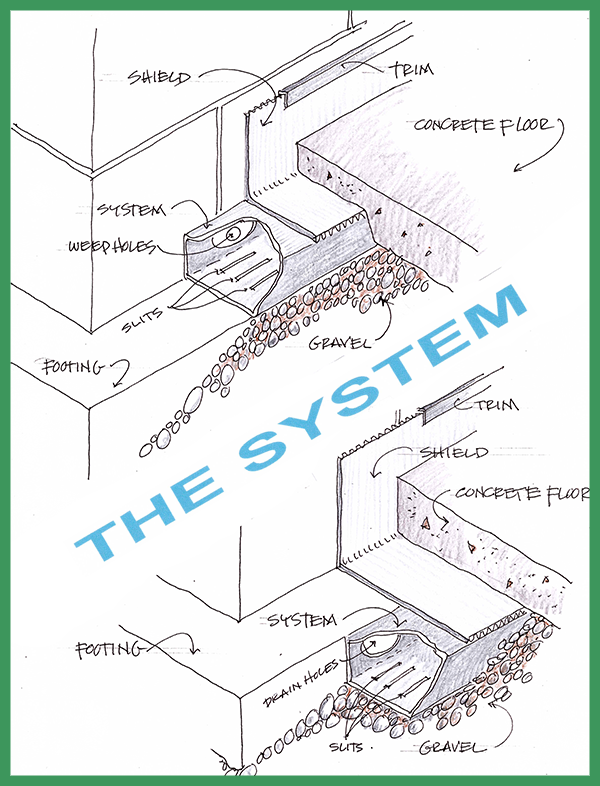Interior Perimeter Basement systems
Interior perimeter basement systems play a pivotal role in safeguarding basements from water intrusion, yet many homeowners remain unaware of their benefits. These systems, comprised of perforated pipes and gravel, are designed to capture and redirect water away from basement walls, effectively preventing costly water damage. By mitigating the risk of mold and mildew, they contribute to a healthier living environment and extend the lifespan of the foundation. However, what truly sets these systems apart from other drainage solutions, and how can one choose the best option for their home? The answer lies in understanding their unique features and advantages.
Understanding Interior Perimeter Drains
An interior perimeter drain is a essential component in managing basement water intrusion and preventing potential damage. These systems are strategically installed along the interior basement walls at the lowest point to effectively capture and reroute any water that seeps in. By directing this water to a designated outlet, such as a sump pump or drainage system, they help keep the basement dry and minimize the risk of flooding.
Interior perimeter drains typically consist of perforated pipes surrounded by gravel to facilitate efficient water collection. The pipes are often covered with a mesh sock to prevent soil and debris from clogging the system. This setup guarantees that water can enter the pipes without any blockages, maintaining a consistent flow toward the drainage outlet.
Sloped basement floors enhance the efficiency of interior perimeter drains by guiding water toward the drains naturally. This method not only protects the basement from water damage but also helps in preserving the integrity of the home’s foundation. Effective installation and maintenance of interior perimeter drains are essential for homeowners looking to safeguard their properties against the hazards of water intrusion.
Benefits of Interior Basement Systems
Interior basement systems offer homeowners significant advantages in protecting their properties from water damage and maintaining a dry living environment. These systems are particularly effective at collecting and redirecting water that seeps into basements, ensuring it doesn’t accumulate and cause damage. By preventing moisture buildup, they reduce the risk of mold and mildew growth, which can lead to serious health issues and structural damage.
One of the key benefits is the ease of installation and maintenance. Interior systems don’t require extensive excavation like exterior drains, making them less disruptive and more cost-effective. They are typically installed along the basement walls and floors, capturing water at its entry point and directing it to a sump pump or other drainage outlet.
Moreover, interior basement systems enhance the longevity of a home’s foundation. By managing water flow efficiently, they prevent hydrostatic pressure buildup against basement walls, which can lead to cracks and structural issues over time. This proactive approach to water management not only preserves the integrity of the home but also increases property value by maintaining a safe, dry, and usable basement space.
French Drains
French drains are a traditional and effective method for directing water away from a home’s foundation. These systems consist of perforated pipes buried underground, surrounded by gravel and soil. The pipes are covered with a mesh sock to prevent soil from clogging the system, while still allowing water to flow through.
In an exterior setup, French drains are positioned along the edge of the foundation to intercept water runoff before it can seep into the basement. The gravel and soil layers act as filters, ensuring that only water reaches the perforated pipes. This setup efficiently directs water away from the foundation, reducing the risk of flooding and water damage.
For interior systems, French drains are installed at the lowest point of a basement, often along the walls. The basement floor is typically sloped to channel water towards these drains. Once collected, the water is transported to a designated outlet, such as a sump pump or swale, for proper drainage.
French drains are especially useful for homes with frequent water issues, as they provide a reliable solution for managing excess moisture. By keeping the foundation dry, they help prevent structural damage and the growth of mold and mildew.
The Basement Waterproofing System
- A non-clogging waterproofing system that will accommodate virtually any residential structure.
- It can sit on top of the footing, or in cases of a high footing or the installation of I Beams it can sit beside the footing.
- The System works on water pressure instead of gravity. Water will be forced laterally to a low point-drop pipes in a sump liner.
Why The System will not clog?
- The location on or beside the upper portion of the footing coupled with a significant gravel barrier will enable The System to collect water and not silt, sediment, or mud.
- The System does not work on gravity and cannot lose it’s slope thus trapping unwanted silt, sediment, or mud.
- The System once it’s work is completed will bleed any water or unwanted debris out of the System via the slits underneath, essentially drying out until the next time it is needed.



